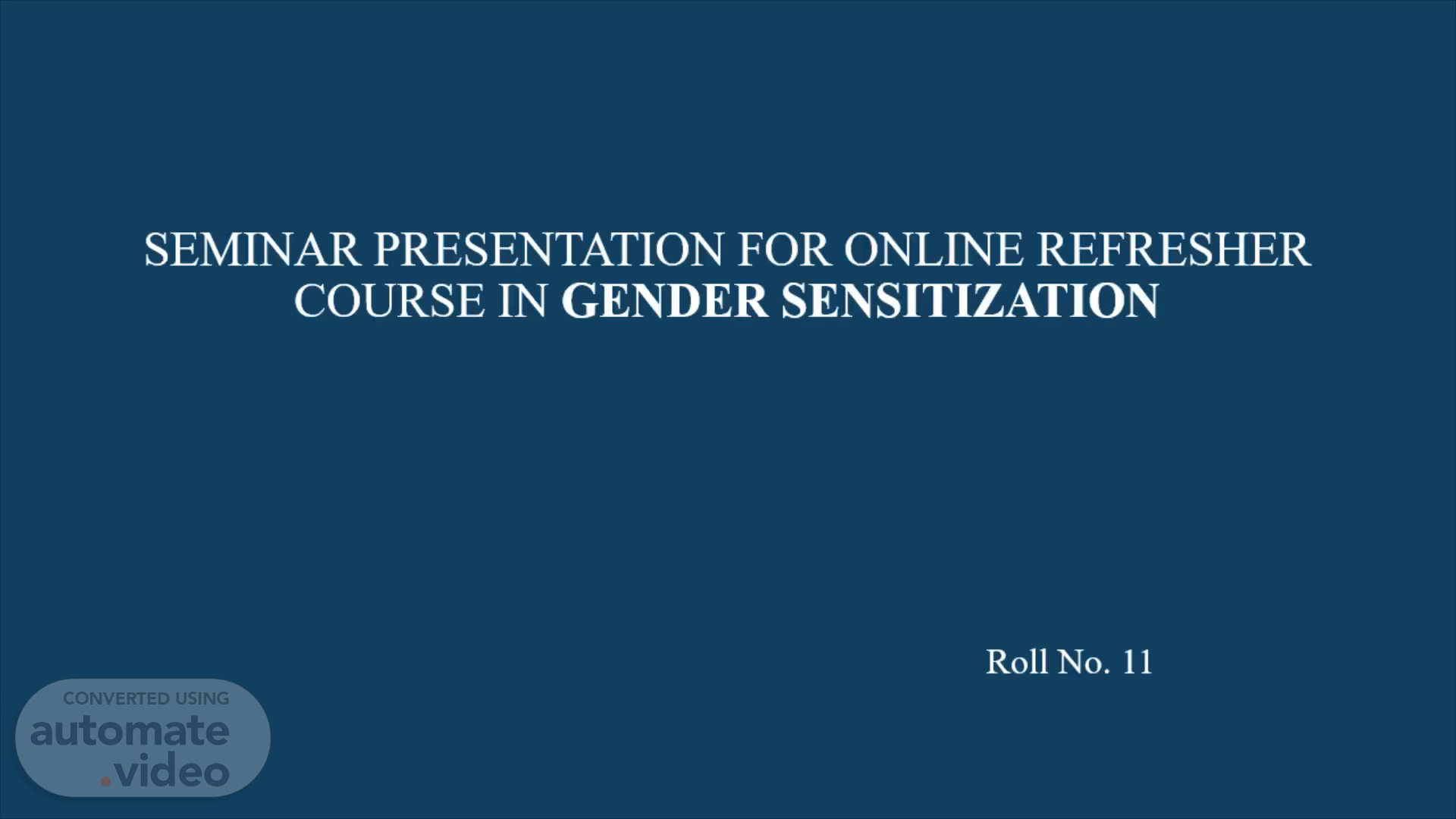
Page 1 (0s)
SEMINAR PRESENTATION FOR ONLINE REFRESHER COURSE IN GENDER SENSITIZATION.
Page 2 (7s)
Introduction. What is Gender Sensitization. Table of Content.
Page 3 (46s)
Gender Sensitization in the Constitution of India.
Page 4 (1m 17s)
Modification of behavior To behave in a manner which is sensitive to gender justice Changing behavior and instilling empathy Helps people in examining their personal attitude Against harassment at various levels.
Page 5 (1m 56s)
Gender Equality and Women Empowerment. Gender Equality Women Empowerment Equal access to resources and opportunities The World Bank also defines the term empowerment as “the process of increasing the capacity of individuals or groups to make choices and to transform those choices into desired actions and outcomes Gender equality is the responsibility of all “Empowerment is an active, multi-dimensional process which enables women to realize their full identity and powers in all spheres of life”. “Empowerment is multi-dimensional and refers to the expansion of freedom of choice and action in all spheres (social, economic, and political) to shape one’s life..
Page 6 (2m 45s)
A way to reduce barriers to personal and economic development created by sexism..
Page 7 (3m 28s)
Is a democratic constitution.. Corrects the historic and economic invisibility of women..
Page 8 (5m 8s)
Dr. B. R. Ambedkar Idea of Equality. Class Liberty Caste Equality Gender Fraternity.
Page 9 (5m 40s)
Gender Sensitivity in the Constitution of India. The Indian Constitution enshrines the proposition of gender parity in its Preamble ,Directive Principles, Fundamental Duties, and Fundamental Rights . Not just does the Indian Constitution guarantee women equal rights, but it also authorizes the Centre to take effective inequity actions in support of women..
Page 10 (6m 8s)
Constitutional Provisions. Right to Equality Article 14 guarantees that the State shall not deny equality before the law and equal protection of the laws. Article 15 prohibits discrimination against any citizen on the ground of sex. Article 15 (3) empowers the State to make positive discrimination in favor of women and children. Right to Equal Opportunity Article 16 - provides for Equality of Opportunity in matters of public employment Article 21 - Protection of Life and personal liberty Article 23 - prohibits trafficking in human beings and forced labour Right to Adequate means of Livelihood Article 39 (a) and (d) enjoins the State to provide equal means of livelihood and equal pay for equal work..
Page 11 (7m 46s)
Constitutional Provisions. Right to Human Condition of work Article 42 enjoins upon the State to make provisions for securing just and humane conditions of work, and for maternity relief; • Article 51A(e) imposes a Fundamental Duty on every citizen to renounce the practices derogatory to the dignity of women Right to Reservation in Local Bodies Article 243D (3) provides that not less than 1/3rd of the total number of seats to be filled by direct election in every Panchayat to be reserved for women, and such seats to be allotted by rotation to different constituencies in a Panchayat In pursuance of the above Constitutional provisions, various legislative enactments have been framed to protect, safeguard and promote the interests of women.
Page 12 (8m 36s)
Statutory Safeguards for Women in India. These safeguards can be divided into 3 major groups as Right to Live The Medical Termination of Pregnancy Act 1971 Commission of Sati (Prevention) Act 1987 Pre-Conception and Pre-Natal Diagnostic Techniques (Prohibition of Sex Selection) Act 1994 Right to Safe Life Immoral Traffic Act 1956 National Commission for Women Act 1992 Domestic Violence (Prevention) Act 2005, The Sexual Harassment OF Women At Workplace Act 2013.
Page 13 (9m 22s)
Statutory Safeguards for Women in India. Right to Live With Pride The Family Court Act 1984 The Indecent Representation OF Women (Prohibition) Act 1986 The Maternity Benefits Act, 1961 Employees State Insurance Act 1948, The Married Women Property Act 1874.
Page 14 (9m 43s)
Conclusion. Through gender sensitization Constitution of India envisaged an egalitarian society which upheld the following principles. Equal opportunity Empowered citizenship Social inclusion Diversity representation.
Page 15 (10m 1s)
References. Catharine, A. M (2006): Sex equality under the Constitution of India: Problems, prospects, and ‘‘personal laws’’. Int’l J Con Law, Vol4, No 2 p. 181-202. 2. Manisha and Mangla , S (2018): Gender Equality in Indian Constitution .International Journal of Research and Analytical Reviews Volume 5, Issue 1, p. 1333-1338. National Commission for the Promotion of Equality Malta A Gender Sensitivity Manual September 2008 p. 79 4. National Commission for Women Gender Sensitization Module (2019): ‘Gender Sensitization and Legal Awareness Programme in collaboration with Kendriya Vidyalaya Sangathan for Class 11th and 12th of Kendriya Vidyalayas ’. NCWGSM: New Delhi, P 36. Singh, A V and Joarder , S (2021): Women empowerment and Gender sensitization: Facts and Realities. IOSR Journal of Humanities and Social Science (IOSR-JHSS) Volume 26, Issue 3, Series p.25- 29. 6. Suteu , S and Darji , I (2015): ABC for a Gender Sensitive Constitution: handbook for engendering constitution making writers. France: Euromed Feminist Initiative IFE-EFI p.122.